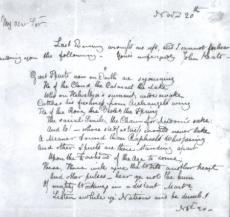
Email: lienaaltai@icloud.com
Total Article : 47
About Me:Sixth form student with an interest in a wide variety of topics such as languages, history, philosophy, politics and literature

From this moment, Keats began to write frequently and fervently. The following year, 'Endymion' was published. This poem was four-thousand lines long and based on the Greek myth with the same name. In order to complete this poem, Keats wrote forty lines a day. Similarly to Hunt, Keats’s controversial and bold style earned him large amounts of criticism from famous critics. However, this criticism made Keats nervous to publish his poem “Endymion”. Much to the fears of Keats, the poem received a huge amount of criticism, and Keats’s anxieties and torment increased.
Keats soon began to recover, and begun to move beyond 'Endymion'. By the end of 1817, he was analysing the role of poetry in society. He wanted to write poems based on empirical beauty - beauty experienced in the world rather than a mythical beauty that was prominent in poetry at the time. His doctrine of 'Negative Capability' was also being developed, exploring the idea that humans can transcend the societal constructs and constraints creatively and intellectually. His revolutionary thinking outlined a chaotic, creative and free world. Keats thought outside the box, and began to mature both as a thinker, and as a poet.
In the summer of 1818, Keats travelled to Scotland. In Scotland he experienced the beauty of nature that he never saw in the city of London. He then returned to London to care for his brother, who had fallen victim to tuberculosis. In this period of his life he also fell in love with Fanny Brawne. He wrote one of his most famous sonnets titled “when I have fears that I may cease to be”, and began to explore deep themes in his poetry. His poems also looked at love, seen in his poem “Isabella” of a woman who falls in love with a man beneath her in social class. His Poem “Ode to autumn” described a rich, natural scene. Its serenity and beauty encapsulated the mournful acceptance of autumn, and forged Keats’s poetic style into history
The Death of Keats’s brother however drew Keats’s writing to a close. In all, Keats published three volumes of poetry but managed to sell only a meagre 200 copies of his work before his death. Keats’s followed in his father and brothers footsteps, contracting tuberculosis in 1819. He deteriorated rapidly, moving to Italy in search of warmer weather. Upon his arrival in Rome, Keats quickly fell very ill. His agony was severe, aided not by the diet of an anchovy and a piece of bread a day to limit the flow of blood to his stomach. He is said to have died holding the hand of his friend Joseph Severn as he died.
Keats’s poetry would later go down as legendary, yet the troubled writer never experienced this appreciation in his lifetime. His short lifespan produced some of the most incredible writing in English history, and John Keats will forever be a treasure and pride in English literature.

0 Comment:
Be the first one to comment on this article.